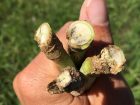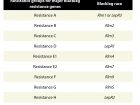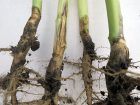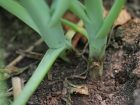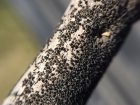
Features
Agronomy
Diseases
Developing the new blackleg resistance labelling systems
Blackleg levels on the Prairies have been going up, but research information on blackleg races and cultivar resistance, plus a new cultivar labelling system and a new diagnostic test, can help bring those disease levels back down.
January 23, 2018 By Carolyn King
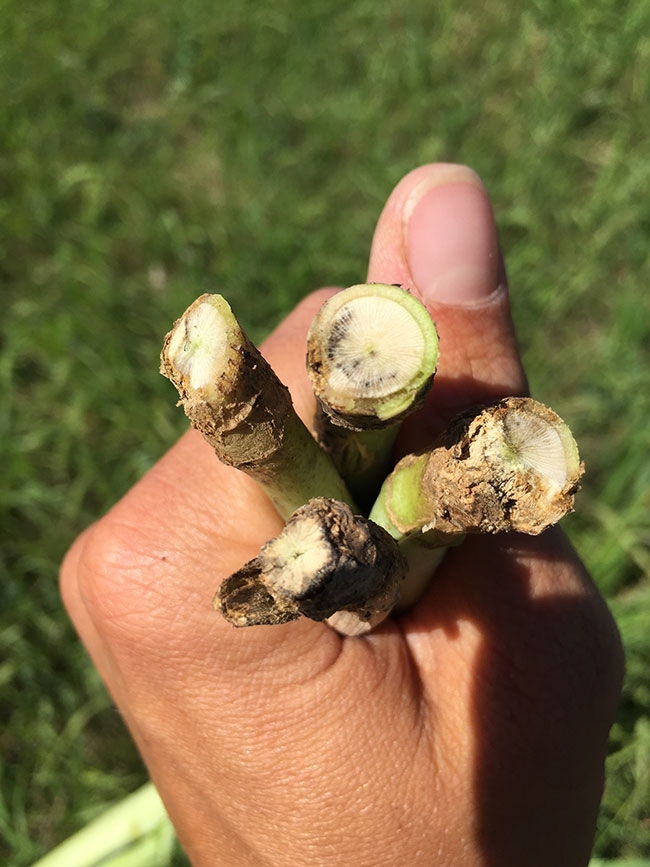 A cross-section of the base of a blackleg-infected canola stem shows blackened tissue from the infection.
A cross-section of the base of a blackleg-infected canola stem shows blackened tissue from the infection. Blackleg is caused by two fungal pathogens. Leptosphaeria maculans, the main concern, is highly virulent; Leptosphaeria biglobosa is weakly virulent. The disease starts with spores infecting canola cotyledons (the first leaves to appear from a germinating seed). The infection develops and spreads, eventually causing cankers at the base of the stem. Blackleg can result in serious yield loss in susceptible varieties.
On the Prairies, the disease was first detected in the mid-1970s. It became a very serious concern in the late 1980s and early 1990s. Then resistant varieties were introduced, which greatly decreased disease levels. The levels remained low from about 2000 to about 2010, but have been creeping up ever since.
Agronomy specialist Justine Cornelsen, the blackleg lead for the Canola Council of Canada (CCC), emphasizes that blackleg is still at fairly low levels in most of the Prairies. “Currently, the average blackleg incidence – the number of plants in a field that are infected – is around 15 per cent on the Prairies, with the 10-year average being under 10 per cent for the three provinces. And for blackleg severity, the averages are usually around one [on a scale where zero is no disease and five is dead from disease]. Only the odd producer or the odd field has struggles with this disease.”
Two main factors are likely causing the recent rise in blackleg. “We are seeing tightened rotations with canola every second year. But for blackleg management, we need about a four-year rotation to let the stubble break down and get rid of the fungus,” Cornelsen says.
“Another factor is that the pathogen is overcoming the resistance available in canola varieties. We have the same resistance package in a lot of our varieties, and because we have used that resistance package over and over again, the pathogen has slowly altered to overcome that resistance.”
Two types of blackleg resistance are used in canola varieties. One is called qualitative or major gene resistance. The other is called non-race-specific, quantitative, or minor gene resistance. The resistance breakdown on the Prairies is associated with major gene resistance.
“Major gene resistance can be quite effective if used properly because it stops the infection right at the spot of entrance,” explains Gary Peng, a research scientist with Agriculture and Agri-Food Canada (AAFC) in Saskatoon. “In this type of resistance, the blackleg pathogen-host interaction seems to be a very classical example of a gene-for-gene interaction. That means for a major resistance gene to work, the corresponding avirulent gene also needs to be at high levels in the pathogen population.” For instance, the major resistance gene Rlm3 is only effective against the pathogen carrying the avirulence gene Avrlm3 (abbreviated to Av3).
Blackleg race dynamics
“About 14 major resistance genes have been identified. To use them effectively, we need to know which races are in the pathogen population,” says Peng, who is leading a project to monitor Prairie blackleg races.
It is a continuation of studies in 2007, led by Randy Kutcher who is now at the University of Saskatchewan, and in 2010-2011, led by Dilantha Fernando from the University of Manitoba.
Peng’s project runs from 2012 to 2017 and is funded by Alberta Canola, SaskCanola, Manitoba Canola Growers and the Western Grains Research Foundation. He has recently been granted funding for five more years of monitoring starting in 2017.
His current project uses two methods of collecting race data across the Prairies. One method is to take samples randomly from commercial canola fields. The other method involves collecting samples from Westar trap plots; this canola cultivar doesn’t carry any major resistance genes, so the race data are less likely to be skewed by the cultivar’s resistance. Peng is finding the two methods produce similar results, so he will likely just use one of the methods in the future.
In 2015, Peng and his research team also monitored blackleg races at 10 co-op trial sites where canola varieties are tested for blackleg resistance. He explains that race information for those sites could be helpful in analyzing varietal resistance performance. Also, the co-op sites are very useful for tracking race trends because their locations and field sizes are more stable than the trap plot sites. The team will revisit the co-op sites, tentatively in 2018, to see how the races have changed since 2015.
To determine which avirulent races are present in the samples, Peng’s team tests the fungal isolates against a set of differential Brassica lines, some of which were developed by his colleague Hossein Borhan. The lines carry different resistance genes; for example, if the differential line has Rlm1 and has a resistant reaction to an isolate, then that isolate may carry Av1.
The project’s results indicate the Prairie blackleg population is very diverse. Up to 90 races have been identified.
One clear trend over time is that Av3 has decreased significantly. Peng says, “Av3 was in about 40 per cent of the pathogen population in 2007. Now Av3 is very difficult to detect across the Prairies.”
He explains, “When the pathogen population changes, often the driver is the R gene we use in our varieties. In working with Dilantha Fernando’s lab at the University of Manitoba and in our own work, we found that most commercial canola varieties or breeding lines we looked at carried Rlm1 or Rlm3 or both. That is probably why the corresponding avirulent genes have become so low in the pathogen population.” For instance, Rlm3 was first deployed in the early 1990s. Over time, through ongoing selection pressure on the pathogen, Av3 gradually changed to a virulent type.
“Another trend is that Av7 has been increasing over the last five or six years, and it is now at a high level across Western Canada,” Peng says. “Av6, Av4 and Av2 are at moderate to high frequencies.”
Beyond major gene resistance
So, the major resistance genes currently in most canola varieties are no longer very effective, and yet we do not have a severe blackleg epidemic on the Prairies. “We see blackleg everywhere, but severely damaged fields are still quite isolated cases,” Peng says. “The disease is a little more noticeable in southern and southeastern Manitoba. In some other areas, high blackleg levels are more related to back-to-back-to-back canola rotations. And some severely damaged fields are related to hail damage or more severe root rot and root maggot damage and sometimes flea beetle damage on the cotyledons.”
Those facts suggest several things to Peng. One is that, in addition to major gene resistance, many cultivars have non-race-specific resistance. Two, this non-specific resistance seems to have been the backbone of blackleg resistance on the Prairies for the last few years. And three, this non-specific resistance may not be as effective when the plants have some physical damage or when inoculum levels are really high due to continuous canola.
In another project, Peng is taking a closer look at non-race-specific resistance. This three-year project, now in its second year, is supported through the grower-funded Canola Agronomic Research Program.
One objective of the project is to characterize the non-race-specific resistance in Prairie cultivars. “We are mostly looking at commercial varieties that carry the Rlm1 and Rlm3 genes but in different backgrounds because we are not sure if non-race-specific resistance is caused by a multi-gene background or by an interaction between the two major resistance genes that may not be a gene-for-gene interaction but still has some effect on the pathogen,” Peng explains.
Another objective is to examine the effects of environmental stress, especially high temperature stress, on the level of non-specific resistance in different canola varieties. Peng notes, “In Australia they think stress conditions in the later growing stages, like hot and dry conditions, really exacerbate infection development. In those conditions, they thought their quantitative resistance alone would be insufficient.”
A key part of the project is to examine the molecular mechanisms of non-race-specific resistance, to see if they differ between varieties and how the mechanisms compare to major gene resistance.
Peng and his team are finding non-race-specific resistance in many of the resistant varieties appears to slow the pathogen’s spread. “After it infects the cotyledon tissue, the pathogen seems to move much more slowly than in a susceptible variety. Often it may not reach the stem through the infected cotyledon petioles before the whole cotyledon drops off,” he says.
Peng thinks this mechanism of resistance could be quite important on the Prairies. “Cotyledon infection is important in Western Canada mainly because we have a much shorter growing season, 90 to 100 days to maturity, versus other jurisdictions where they have 180 to 300 days for a canola or rapeseed crop. So in Western Canada, if the infection doesn’t get going on the cotyledons, then it is very difficult for the infection to develop into the stem from the true leaves later on [because there is not enough time].”
New labelling, new diagnostics
A recently approved seed labelling system can help growers with blackleg problems when selecting their canola varieties.
“In Canada, we have talked about a labelling system [for resistance genes] for five or six years. But recently we started to see a little more push. Blackleg levels are starting to rise, which is moving the disease to the top of producers’ minds. Also, we’ve got new yield data that shows the actual loss associated with the disease, which helps show how much blackleg is actually hurting Canadian producers. And blackleg is a trade concern. All those factors are bringing awareness to the whole canola value chain in Canada that we need to minimize blackleg in our production areas,” Cornelsen explains.
“So our blackleg steering group, which is comprised of researchers, seed companies, growers, [provincial extension staff and others], helped to form a labelling system based on what we currently know about the Canadian situation. We based our system on systems used elsewhere in the world; it’s very similar to the Australian system. We produced several different models and they were voted on at the Western Canadian Canola/Rapeseed Recommending Committee [WCC/RRC] pathology meeting [in February 2017].”
The resistance genes are placed in groups identified by a letter (see Table 1). “Right now we have roughly 10 major gene resistance groups based on the actual resistance genes we found in varieties/breeding lines a few years ago. A few of the resistance groups aren’t in Canadian varieties yet, but they are used in other breeding programs and we hope to have them in our varieties eventually,” Cornelsen says.
In the new system, the variety’s resistance group is paired with its blackleg resistance rating of resistant (R), moderately resistant (MR), moderately susceptible (MS) or susceptible (S). Peng advises, “With the new labelling, the first category to look at is the overall performance rating based on field trials, that R, MR, MS or S rating, and then look at the type of resistance gene involved.”
Resistance gene labelling is voluntary for the seed companies. “Several seed companies are quite interested in resistance gene labelling and hope to have their labels out within a year,” Cornelsen says. At least one company, Dekalb, is using this new labelling system in its 2018 seed guide.
A newly developed diagnostic test will make the labelling system even more helpful.
“Hossein Borhan’s group recently developed a rapid test for blackleg races. They have sent out the markers and a protocol to diagnostic labs that want to evaluate it and see if they will offer it in their labs. Hopefully by next year they’ll be able to provide the service to producers,” Cornelsen says. “So producers will be able to collect stubble from their fields, send it to a lab and find out which blackleg races are in their field. Of course, the pathogen is very diverse so producers will have several races within a field. But hopefully they will be able to match a resistant canola variety to the top race in their field.”
Keeping a lid on blackleg
“The canola varieties we have now are fantastic and work really well,” Cornelsen notes. “The resistance gene labelling is an added dimension, enabling growers to change up the genetics that they are deploying. It will really help to tighten up resistance stewardship for the long run.”
“However, this labelling system will not solve all the problems for those few producers who have a tighter rotation and are struggling with managing the disease,” she adds. “Producers still really need to scout for the disease and know what they are looking for; blackleg can be easily mistaken for other diseases. And they need to extend the rotation. Any extension gives another year of breakdown to get rid of some of that stubble.”
According to Peng, another thing that could help keep a lid on blackleg levels is improved monitoring of the pathogen’s races. “Right now we can only do big picture monitoring for the Prairies. Although we’re developing more efficient techniques, at this point we can only test a maximum of about 600 isolates over a year.”
Better race information would help in deploying major gene resistance more effectively. “For example, right now if Rlm7 is incorporated into our varieties, it would quickly suppress the disease level quite effectively,” Peng says. “And if we can stabilize or reduce blackleg levels and reduce seed contamination and dockage, then that might be a very positive image to our export customers concerned about the introduction of the disease.”
Continued work on non-specific resistance is also important. “The major R genes will be eroded eventually, or even fairly quickly, because of the selection pressure on the pathogen population. From our monitoring data, we know that for pretty much every known major resistance gene, we have at least one race already in Western Canada that can overcome it right away. So it is just a matter of time before any of those major genes is eroded after extensive use,” Peng explains. “It will be important to keep our good non-specific resistance materials in our breeding efforts, while introducing some new major genes into this background. That will make the resistance in our varieties more robust.”
